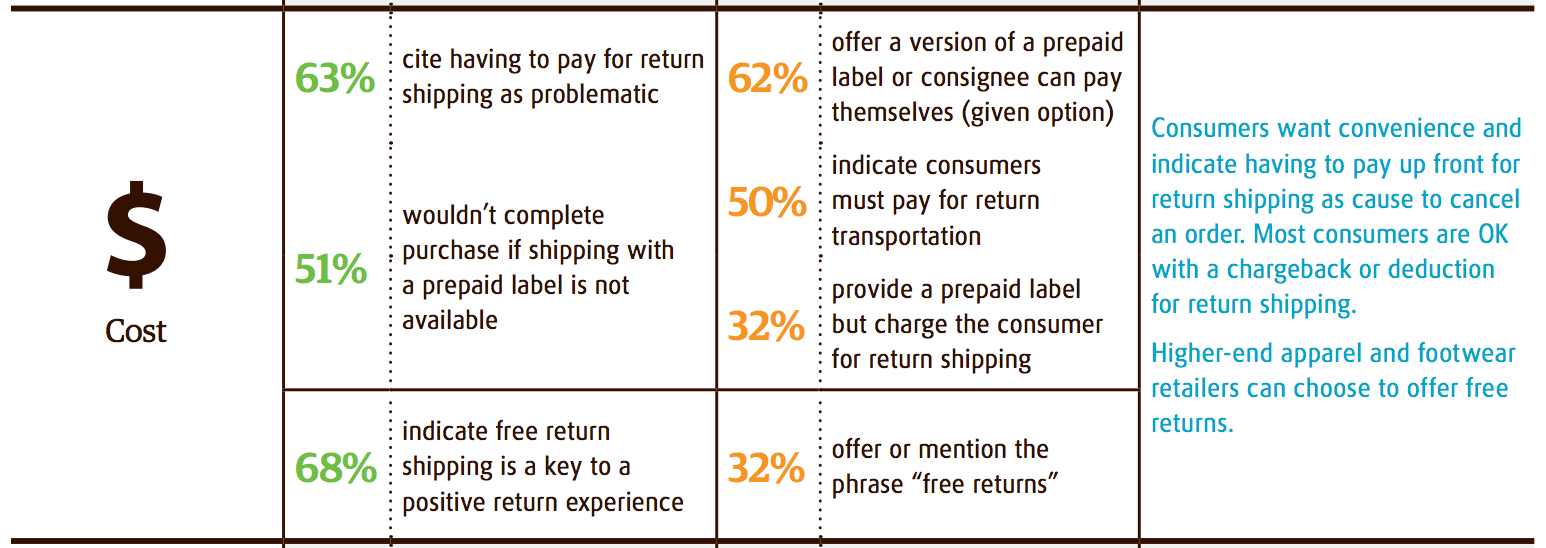The return of the holiday season marks the return of one of e-retailers’ most despised pains — returns.
But before we get into how to handle them, it’s better to talk about how to best reduce the risk of them occurring.
As ecommerce takes off, it’s inevitable that the rate of returns follows suit; more orders, more chances of it happening. And ecommerce, by its very nature, is prime territory for returns.
It isn’t surprising that consumers care a ton about returns when purchasing online. Ecommerce denies them the chance for a first-hand experience with the product before buying. They’re relying on marketing, word-of-mouth, and reviews to justify a purchase.
They’re trusting e-retailers that their product is worth it. And a first step to building that is a returns policy, something that often seals the deal, convincing consumers to trust you enough to throw down their credit card digits.
Put Your Returns Policy to Work
Your returns policy is the primary weapon at your disposal for crushing the threat of returns, and there are several aspects of it that you’ll need to define and refine it.
Don’t be too wordy — Conciseness is key when dealing with anything related to consumers. Plenty can be involved with returns policies, so being straightforward with the process is the avenue to go down.
Avoid using the words “you must” or “you need to” — Keep in mind that consumers aren’t fans of having to perform a bunch of things to return an item, so make sure language is as non-threatening or demanding as possible. Avoid “you,” and instead focus on actions like “print out the shipping label,” rather than “you need to print the shipping label.”
Walk through the process — This is the meat of your returns policy, the agreement between you and customers that establishes what each party must do in the event.
- Who’s dealing with packaging — Do customers need to use the original packaging? If it’s not possible, will they have to get their own packaging or will you offer some?
- Where do orders need to be sent back to — This is dependent on the product and its fulfillment method. For instance, if you’re fulfilling in-house the return gets sent right back to the address it was delivered from. But if you’re dropshipping or outsourcing fulfillment, you’ll need to determine whether the returns should be headed your way for feedback or back to your supplier or third-party logistics provider.
- What must be included with the return — Define all the necessary components of the return for it to be accepted. This can include proof of purchase like receipt or packing slip, an image of the product or packaging if damaged on arrival, as well as some constructive feedback.
- Who’s paying for shipping — Is it worth covering the cost of the shipping return label? It’s important to note that consumers are not fans of having to pay for returns these days (as if they ever were), and it will impact their purchase decision both before and after sale. Just check out these stats from UPS:
- When should the return be sent by — Define the amount of time a customer has to return an item. Some merchants are more laid back, leaving the window open for months, others choose to restrict it to weeks to avoid any disputes as soon as possible.
That last bullet is interesting, though. How lenient a returns policy should be is up for interpretation. A study by the University of Texas indicates that a looser returns policy leads to higher purchases. In essence, e-retailers with lenient policies design them that way specifically to boost purchases rather than to reduce returns.
But do keep in mind that the way you develop the leniency of your returns policy should depend on your intentions and products. If the objective of your policy is to drive sales, a loose one may be useful one. But if returns are expensive and burdensome for you — if you frequently ship internationally or are handle larger, heavier products — a policy that’s tighter and more strict might be preferable simply to avoid the hassle.
Begin Showcasing the Policy
Pretty much everyone knows about Zappos by now, the Amazon-bought footwear company. They’re a great example of how returns policies (and killer customer service in general) strengthen trust and persuade consumers to take the plunge.
And since their successes in the mid 2000’s, they’ve put their returns policy at the center of their marketing, touting it to comfort online consumers uncomfortable with purchasing something as need-to-try-on as shoes.
Do the same with your own returns policy. Whether you’re offering a week-long window for a return or a month-long gap, definitely get it in front of your visitors’ eyes as they prowl your site for products. According to a UPS study on thousands of consumers, 15% of them will ditch you if your policy isn’t clear, and 88% of shoppers make a point of reviewing it before purchasing.
There are several straightforward ways to get it in front of their faces, all of which involve marketing — plaster your returns policy on assets like landing page graphics, pop ups, even link or list it next to your product descriptions. You may also want to shoot out an email campaign highlighting it or post about it on social media; any channel consumers are using is an opportunity.
Or just stick to the basics — create a webpage on your website reserved specifically for your returns policy, define it in your Terms and Conditions, your Customer Service section, FAQ, or highlight it on your checkout page. Even include your returns policy and / or a prepaid return label within your packaging if possible.
Be Clear About Your Product
Don’t take your product marketing for granted. It might seem like just another essential part to running an online store, but it can do tremendous good when it comes to reducing return rates.
As mentioned before, the struggle with ecommerce is the fact that consumers don’t get an opportunity to experience your product in person. They must trust you. And the way you market your product can do the trick.
First is product photography and copy. Two-dimensional images and the copy attached to them are the go-to for marketing your product, and first impressions are key. Here’s what you need to include.
Call Everything Out
Consumers need to know the details of what they’re buying. Everything. Any misunderstanding, any detail they didn’t catch, will be a major cause for an irritating return. When you develop your product marketing, make sure the product’s specifics are each called out, listed prominently.
Selling apparel, products legendary for their high return rate? Call out the different styles, sizes, colors, and materials of your offerings. Selling chairs? Include colors, materials, sizes, weight tolerance, and any other pertinent information that a customer needs to be aware of, even if it’s something like “not meant to be in the sun for long periods of time.”
Be Amazingly Realistic
Two words that seem to contradict each other, product photography that’s amazingly realistic is perfect for accurately and effectively marketing your products.
You must set expectations. A consumer that’s impressed by an over-done product image could be let down once it arrives on their doorstep, heightening the risk of a return. A product image that’s unclear and ugly won’t get you a sale. That’s why a product image that’s straightforward is preferable.
Here are some pointers as you take those photos:
- Snap photos against a white backdrop — Avoid distracting your potential customer. Avoid backgrounds that take any attention away from your product. That’s why white backdrops are preferable for photography; because they’re stale and pale, the backdrop emphasizes the product because it’s the only thing there. And the contrast accurately depicts it in terms of shape, color, and size.
- Use lighting — A standard for most photography, take pictures in the light. What kind of lighting you use is debatable — some prefer natural sunlight, others prefer professional or artificial light. But no matter what, let there be light.
- Get rid of the background completely, make it all white — After using that white backdrop, finish the job and get rid of it completely. For all the reasons why white backdrops are preferable, a solid white background is even better. If Amazon does it, it’s probably a good idea.
- Consistency is key — Treat your products equally. When you set your images, use the same pattern and template for each. Not only will this help streamline your process, it’ll ensure a more streamlined and consistent customer experience.
Supplement With Video
Lastly, video can do a solid job of bolstering your product marketing, especially if you’re dealing with products that have some sort of action and use.
Video’s transcendence is real, and consumers are viewing e-retailers’ videos at a growing rate. The reason why is obvious — videos visualize your product in action, bringing the consumer a 3D glimpse of your product that’s just shy of fiddling with the product themselves.
Record your product in action, whether it’s a chainsaw cutting through a shrub like butter or a model walking around in a dress you sell. Put it on YouTube and embed in your site if possible.
One very effective way of incorporating video is by encouraging unboxing videos — a relatively recent phenomenon where bloggers and YouTubers purchase or receive products and record themselves unboxing them. Check out these experiences and why it works.
When you market a product, embed or link to the unboxing videos somewhere near. Not only does this build returns-reducing trust through the fact that it’s real-word footage, it’s also hugely influential social proof — a living, personal review (assuming the video is positive).





